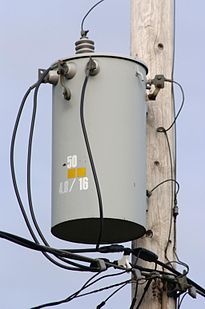A transformer is an electrical device that transfers energy between two or more circuits through electromagnetic induction.
A varying current in the transformer's primary winding creates a varying magnetic flux in the core and a varying magnetic field impinging on the secondary winding. This varying magnetic field at the secondary induces a varying electromotive force (EMF) or voltage in the secondary winding. Making use of Faraday's Law in conjunction with high magnetic permeability core properties, transformers can thus be designed to efficiently change AC voltages from one voltage level to another within power networks.
Transformers range in size from RF transformers less than a cubic centimetre in volume to units interconnecting the power gridweighing hundreds of tons. A wide range of transformer designs is encountered in electronic and electric power applications. Since the invention in 1885 of the first constant potential transformer, transformers have become essential for the AC transmission,distribution, and utilization of electrical energy.[3]



